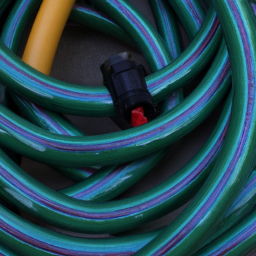Thread Size for Garden Hoses
What Size Thread Is A Garden Hose
What Size Thread Is A Garden Hose? An Exhaustive Exploration
Introduction
Garden hoses are indispensible tools for a successful garden or lawn maintenance. As such, it is important to understand something as basic as what size thread is a garden hose in order to be prepared for any scenario. This is especially crucial if one is replacing a damaged hose, as incorrect thread sizing will result in a leaking or ineffective product. In this article, we'll delve deep into what it takes to correctly size and use garden hoses. Different sizes of garden hoses, usage scenarios, identification methods, and precautions will all be covered.
Types of Garden Hoses
There are two main categories of garden hoses: expandable and non-expandable. Expandable hoses are the most common type of garden hoses, as they are generally lightweight, expandable, and also come with cheap prices. They are primarily made of latex and are considered the most effective for general gardening purposes. Non-expandable hoses are more rigid, durable and heavy duty. They're usually made out of vinyl and designed for industrial or professional use. Non-expandable hoses also tend to be a lot more expensive than expandable hoses.
Thread Types
The two primary threading types of garden hoses are NPT and GHT. NPT (National Pipe Thread) is the most common type of threading and is found in the majority of garden hoses. It is identified by its tapered threads and is usually labeled NPT. GHT threads (Garden Hose Threads) have different dimensions and are sometimes denoted as FHT for Fire Hose Threads. The GHT threading is mainly used with garden faucets and connectors. It is usually labeled GHT for garden hose threads.
Garden Hose Sizes
The size of a garden hose is directly proportional to the diameter of its threads. The standard NPT garden hose connection is inch (15.875 millimeters), while the standard GHT is inch (9.525 millimeters). Since garden hoses can also be connected to standard garden faucets and connectors, the thread sizes can also vary depending on the type of coupling or connector being used. Other sizes include the more uncommon inch (19.05 millimeters) and inch (6.35 millimeters) threads.
Identifying Thread Sizes
It is important to identify the thread size of the garden hose before using it, as the wrong size can result in a leak or an ineffective product. The easiest way to identify the thread size is by using a thread measuring gauge or pipe thread calculator. If those are not readily available, then an approximate estimation can be made by measuring the inner diameter of the thread.
Using a Thread Measuring Gauge
Thread measuring gauges provide the most accurate method of identifying the thread size of a garden hose. They come in a range of sizes from 1/16 of an inch to 3 inches and work by inserting the gauge into the female end of the garden hose. The size of the thread is then determined by the size of the gauge that fits snugly into the thread.
Pipe Thread Calculator
Pipe thread calculators are a great way to quickly and accurately identify thread sizes. The calculator requires some basic measurements, such as the inner diameter of the thread and the outer diameter. It then provides an estimation of the thread size that is usually accurate within a fraction of a millimeter.
Measuring the Inner Diameter
If a thread measuring gauge or pipe thread calculator is not available, then the thread size can be estimated by measuring the inner diameter of the thread. Measure the inner diameter of the female end of the garden hose, and then compare it to a chart of standard thread sizes. This method does not provide the most accurate results, but it is still useful in a pinch.
Usage and Precautionary Measures
Once the thread size has been determined, the garden hose can then be used for its intended purpose. Before using the garden hose, make sure that the hose connections are properly tightened and all the seals are in place. Also, inspect the hose for any signs of wear and tear before further use. A damaged hose should not be used as it can result in a leak or an ineffective product.
Insights
Garden hoses are an essential tool for gardening and lawn maintenance and understanding the size and type of threading is important for its proper usage. There are two main types of garden hoses: expandable and non-expandable. Furthermore, the two primary threading types of garden hoses are NPT and GHT. The thread size of a garden hose can be determined by using a thread measuring gauge, a pipe thread calculator, or measuring the inner diameter of the thread. Lastly, before using the garden hose, make sure that the hose connections are properly tightened and all the seals are in place. Inspect the hose for any signs of wear and tear before further usage.
Closing Remarks
Garden hoses come in many different shapes and sizes. While the standard garden hose thread is usually a universal size, it is important to be aware of the different types and sizes of threads that can be found in garden hoses. Knowing how to correctly identify, use, and maintain garden hoses can save time, money, and frustration in the long run. Always be sure to properly inspect a garden hose for any signs of damage before using it.

Previous Page
Next Page
